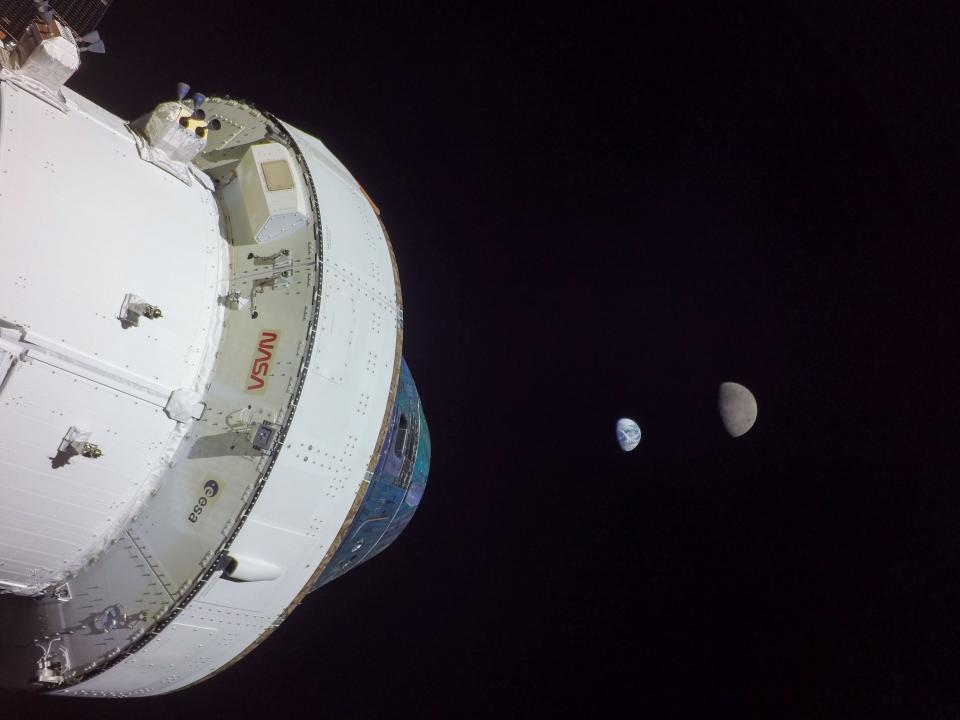NASA's Orion spaceship has sights set on Earth after departing lunar orbit
---
NASA's Artemis I mission began the last leg of its deep-space journey Thursday when an Orion spacecraft departed lunar orbit, but the trip back to Earth isn't quite yet underway. It first has to swing by the moon again for a gravity-assist maneuver early next week.
Thursday afternoon, the uncrewed spacecraft powered up its largest engine for a 105-second burn. The maneuver propelled Orion out of its distant retrograde orbit, or DRO, around the moon and committed it to a path back to Earth, skirting the lunar surface along the way.
"It's been a fantastic mission, but all great things must come to an end," NASA spokesperson Dan Huot said during NASA's livestream of Thursday's burn.
Next, Orion will fire up its Orbital Maneuvering System engine once more on Monday, Dec. 5, for the powered return flyby, a burn similar to last week's powered outbound flyby.
The Orbital Maneuvering System engine is a repurposed piece of space shuttle hardware flying for the first time on Orion, having last flown during the STS-112 mission in October 2002. It joins over 30 other engines on Orion's powerhouse, a service module built by the European Space Agency.
Monday's powered flyby will again position Orion close to the surface at less than 80 miles like last week's maneuver that flung Orion into its distant retrograde lunar orbit. This time, however, it will harness the moon's gravity while aimed at Earth for its return trip home.
The return powered flyby will swing Orion past the Apollo 12 and 14 landing sites during daylight this time, but by the time Orion gets there, it will be positioned about 6,000 miles above the lunar surface. That's too far to capture any detailed photographs.
"We are absolutely going to be pointing cameras at that area. But these are essentially GoPro cameras and we're 6,000 miles away," Zebulon Scoville, NASA flight director, told reporters on Wednesday.
"You can imagine being in Houston and pointing a GoPro in Paris and trying to see a Volkswagen bus there, you're not going to see it," he said. "It'll be more of a tip of the hat and a historical nod to the past as we fly this spaceship to the future."
All told, Orion has performed well so far and is expected to keep chugging along for the return leg of the Artemis I mission.
NASA's Chris Edelen, Orion vehicle integration deputy manager, told reporters Wednesday that "things have been very smooth with the spacecraft."
"If this is a new car you purchase, you're going to be very happy," he said. "It's drama-free so far and exceeding expectations."
After coasting back toward Earth for about six days, Orion will ditch the service module before re-entering the atmosphere on Sunday, Dec. 11. It will then descend under a parachute canopy for a 12:42 p.m. EST splashdown in the Pacific Ocean off the coast of California, marking the end of Artemis I.
If all goes well, the splashdown will pave the way for NASA to execute a similar mission in the form of Artemis II. Though the mission profile looks similar to Artemis I, it will include astronauts. Then, Artemis III will aim to put two astronauts on the lunar surface before 2030.
Jamie Groh is a space reporter for Florida Today. You can contact her at JGroh@floridatoday.com. Follow her on Twitter at @AlteredJamie.

This article originally appeared on Florida Today: NASA's Artemis I Orion departs lunar orbit, heads back toward Earth

